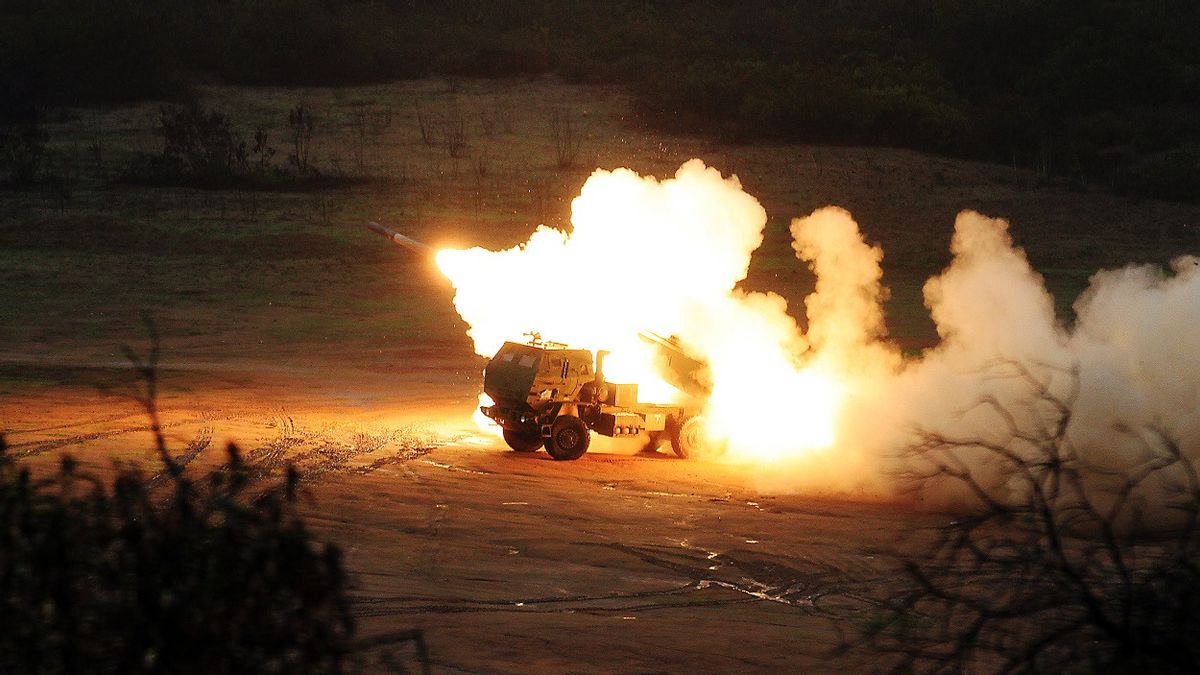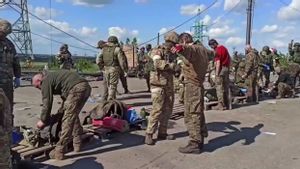JAKARTA - The M270 MLRS and M142 HIMARS rocket launcher systems, which the West is supplying to Ukraine under a new military aid package, are the most formidable of all weapons handed over to Kyiv, despite Russian troops being able to resist them.
"Of all the possible armaments supplied by the Western collective, the M270 MLRS (multiple launch rocket system) and the M142 HIMARS (High Mobility Artillery Rocket System), are the most dangerous and capable weapons available to the Ukrainian armed forces that can affect combat operations", said a veteran of the missile and artillery forces Alexey Sakantsev, quoted from TASS June 8.
British Defense Secretary, Ben Wallace, announced in early June that London would send the Kyiv M270 rocket system with ammunition capable of striking targets at a range of up to 80 km.
The decision was synchronized with the delivery of US M142 HIMARS systems and ammunition to Kyiv. The US government previously said the first batch would include four rocket systems, while the hit range of HIMARS to be handed over to Kyiv would not exceed 80 km.

The British M270 and US M142 rocket systems fire the same type of ammunition, with the only difference being, that the M270 is a tracked vehicle with two packages of 6 rockets (or one missile) each. While the M142 HIMARS is a wheeled launcher (mounted on a five-ton truck chassis with an armored cab) with a package of 6 rockets or missiles, he explained.
"These packages are equipped with a fast refilling system and are structurally almost the same as their fire control systems, while standard modules are a huge advantage for logistics, training, and equipment repair", Sakantsev said.
Western multiple launch rocket systems are also distinguished by a wide range of ammunition rounds. As the expert told TASS, both systems use three types of ammunition: 227mm and 240mm rocket shells with wide warhead range, conventional high explosive fragmentation shells to cluster ammunition of several types (capable of striking armor and manpower).
The system can also fire rockets that deliver various mines to targets: these rocket-propelled shells can strike at a range of 45 km to 70 km depending on the ammunition subtype, he explained.
"Importantly, some of them are guided and GPS-adjusted ammunition (NAVSTAR). As a result, these bullets have a low probability of circling error and, therefore, do not require adjustment fire. The target will be hit suddenly and accurately, while in the case of cluster ammunition, massively", he said.

The third type of ammunition for the M270 and M142 rocket launchers is designated as the MGM-140 ATACMS, which is a tactical missile, the officer said.
"Let me mention again, that the M270 launcher can carry two such missiles and the M142 system carries one. This missile also has some different modifications in terms of its warhead and, basically, in terms of flight range which varies between 140 km and 300 km. km. These missiles are also guided munitions (inertial systems adapted to GPS) and have a low probability of circumferential error and often carry cluster warheads", Sakantsev explained.
This rocket system makes it possible to strike targets both near the front line and behind the enemy, he said.
"If the Ukrainian armed forces get their hands on long-range rockets, they will be able to fire on several Russian aerodromes, military bases, and many ammunition depots, command posts, and troop gathering areas, as well as air defense and artillery systems not even in positions but in maintenance, transport and transport areas. and preparation", said the expert.
As another advantage, the US HIMARS M142 launcher is highly mobile thanks to its wheeled platform and can disguise itself as a truck which would make detection and destruction difficult, he said.

However, Sakantsev said Russia could counter these Western rocket launchers with its military-owned missile systems.
"All munitions of this system can be detected in flight and destroyed by advanced Russian air defense systems such as the S-300, S-350, S-400, Buk, Tor-M2, Pantsyr-S, and Tunguska operating in the army and involved in special military operations", he said.
However, Russia's air and anti-missile defenses must be well-arranged to attack US munitions, as rockets and missiles are more dangerous and complex targets than aircraft, he stressed.
It is practically unrealistic to jam the rockets from the M270 and M142 systems guided by GPS signals, the expert said.
SEE ALSO:
"This is possible theoretically and technically but not practical. This is because the signal has to be 'suppressed' along the rocket's flight path, while part of this path extends into enemy territory and it is almost unrealistic to impede the rocket's path over friendly territory based on energy alone", he explained.
He added that the M270 and M142 rocket systems are effective weapons and require serious training to counter them, he said.
"In my opinion, it is very important to destroy such systems in their deployment, before they move into firing positions and the Russian Air Force can fulfill this task. In some cases, this task can be fulfilled by the Iskander-M system and without risk for pilots", Sakantsev concluded, adding that Russia needs to further develop its air defenses, to eliminate the enemy's ability to carry out critical strikes.
The English, Chinese, Japanese, Arabic, and French versions are automatically generated by the AI. So there may still be inaccuracies in translating, please always see Indonesian as our main language. (system supported by DigitalSiber.id)


















